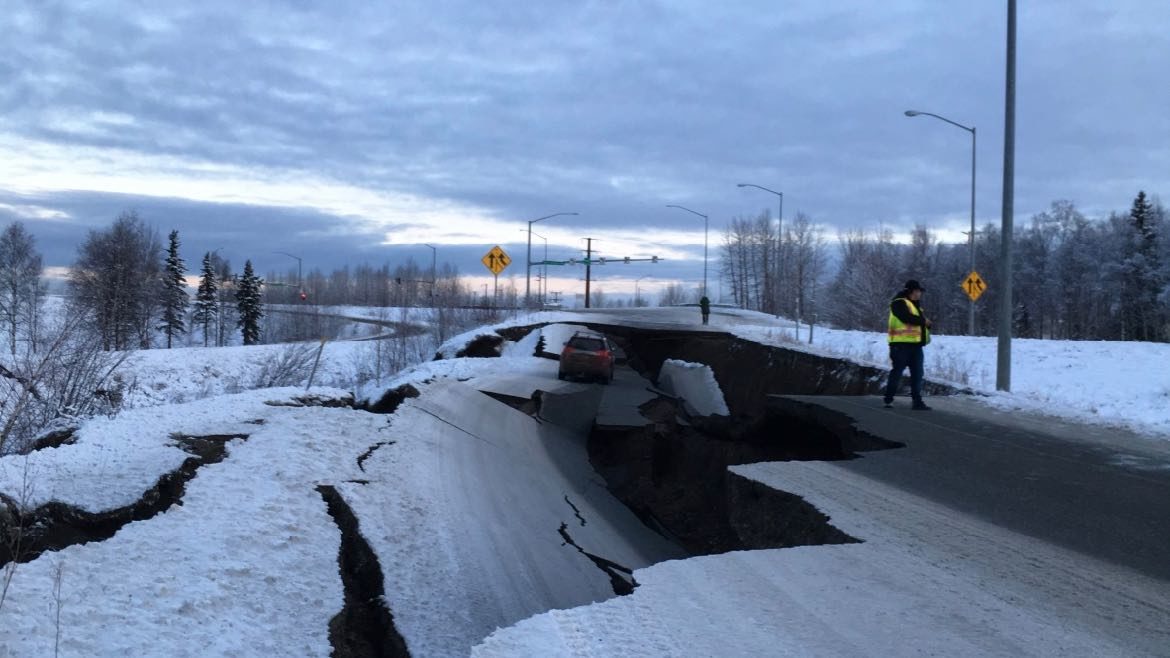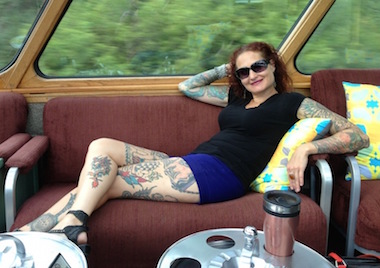Alaska pubcasters pitch in to help Koahnic, station hit hardest by quake damage

Nat Herz / Alaska’s Energy Desk
An Alaska Public Media reporter took this photo of a car trapped Nov. 30 in a crumbled section of off-ramp from a major road in Anchorage.
Public broadcasters in Alaska’s biggest city are trying to get back to normal after the 7.0 earthquake that rattled Anchorage and vicinity Nov. 30, knocking stations off the air and displacing one of them from heavily damaged studios.
The worst of the damage was at Koahnic Broadcast Corp., the native-owned company that operates Anchorage’s KNBA-FM and the Native Voice One network. Its facility in the Cook Inlet Tribal Council’s office building suffered water damage after sprinkler pipes burst.
Alaska Public Media’s KSKA-FM and KAKM-TV were briefly knocked off the air but kept coverage going via streaming and help from other Alaska pubcasters. And Alaska Public Broadcasting Inc., which supplies services to rural Alaska pubcasters, suffered damage to its Anchorage offices but no disruption to its services.
Alaska Public Media CEO Ed Ulman said he was getting coffee in Anchorage’s Midtown neighborhood on his way to work when the quake struck around 8:30 a.m. local time.
“I got in my car and made directly for the station,” he said, where news director Lori Townsend and senior editor Annie Feidt were already gathering information and making assignments for an unusually large newsroom full of reporters. That particular stroke of luck was the result of a scheduled meeting of the statewide Alaska’s Energy Desk regional journalism collaborative. Six reporters from other public stations in Juneau, Bethel and elsewhere were already at the Anchorage station, where they joined another half-dozen local news staffers who spread out across Anchorage and vicinity to cover the story.
At first, they couldn’t broadcast that coverage, since the quake silenced most Anchorage stations, including APM’s KSKA-FM and KAKM-TV. The quake’s epicenter was near the stations’ tower, in the Goose Bay area across Cook Inlet from Anchorage. Ulman said APM staff contacted neighbors near the tower and quickly learned it was still standing, but reaching it proved to be more of a challenge.
The tower is only about 10 miles from the studios, but it’s normally more than an hour’s drive around Cook Inlet to the north, through the Mat-Su Valley. Ulman and his engineering team realized the damaged roads were inaccessible. They contracted with a helicopter company to fly engineers across the inlet to the site.
In the meantime, KAKM-TV continued to feed cable companies for viewers who still had power, while KSKA expanded its web stream’s capacity to serve additional listeners. A fiber connection allowed APM to feed its programming to sister station KTOO in Juneau, which provided additional paths to reach viewers and listeners with internet access.
“They were able to get us a Facebook Live feed,” Ulman said. “We have cameras in our radio studio, and KTOO began pushing that out on 360 North,” a statewide cable channel.
The streaming coverage, anchored by Townsend and reporter Zachariah Hughes, also reached some Anchorage listeners via a low-power community station, KONR-LP, which picked up the feed Monday morning. Meanwhile, APM engineers were at the Merrill Field airport by noon for the short ride to the tower site, where they found and quickly fixed a mechanical issue with the backup generator. KAKM-TV was back on the air by 1:15 p.m., less than five hours after the quake, and KSKA-FM followed quickly afterward.
“We still got our Alaska News Nightly report out statewide, and from what I understand all our public radio colleagues across the state were carrying our live feed on Friday,” Ulman said.
‘People will be dealing with this for a while’
In addition to reporting on road and building damage around Anchorage, the newsroom filled a vital role in quashing rumors and reassuring a jittery community when a tsunami warning went out later Friday. Sitting far inland down Cook Inlet, Anchorage is rarely at risk of tsunamis, and the warning was soon cancelled. But Ulman said he found himself having to reassure PBS staffers who were in downtown Anchorage to conduct a Ready To Learn workshop.
“They called up and said, ‘We can see Cook Inlet from here,’ and I assured them they would be fine,” Ulman said.
The extra reporters from Alaska’s Energy Desk stayed on the job in Anchorage through Saturday, covering damage in the city and the Mat-Su Valley and reporting as state officials assessed the quake’s aftereffects.
“It was great to have those additional reporters,” Ulman said.
As aftershocks have continued to rattle Anchorage – two on Thursday measured 4 or above on the Richter scale, according to Ulman — APM’s team has continued to provide coverage on radio and on KAKM’s Alaska Insight public affairs show, as well as online.
That’s all happening even as staffers cope with the damage from the quake. APM’s chief technology officer, Bob Wyatt, suffered structural damage to his hillside home, Ulman said. “People will be dealing with this for a while,” he said.
Offices of Alaska Public Broadcasting Inc., which provides support to smaller pubcasters across rural Alaska, also suffered damage, said chief engineer Bill Prendergast. Prendergast was alone in the building having his morning coffee when “things started jumping around, and I rolled under the desk quick as a wink,” he said.
“The whole building was rolling around in a weird way for 120 seconds or so, the lights went off in the building … and while I was under the desk, the first thing that rolled over to me was my hard hat,” he recalled. With phones down, it took Prendergast several days to assess what turned out to be only minimal damage at other Alaska stations. In Valdez, 115 miles east of Anchorage, the quake swung out of alignment a satellite dish that receives public radio programming, he said, requiring a service visit to realign it.
Quake displaces KNBA
A few miles away at Koahnic, KNBA morning host Danny Preston was conducting a live interview when the quake hit, said President/CEO Jaclyn Sallee.
“The earthquake hit and the power went out, and we evacuated. Everyone got out safely,” she said. Water damage from broken pipes made returning to the building unsafe, though, silencing KNBA and its full-time Native Voice One and River streaming services. Station affiliates using the Public Radio Satellite System can still receive a Native Voice One feed. KUNM in Albuquerque, N.M., where Koahnic maintains a satellite office, is providing backup streaming for affiliates not connected through PRSS.
Sallee and KNBA Chief Engineer Charles Sather are still trying to gauge the extent of the damage at their facility. Emergency officials gave employees of the small station a two-hour window this week to recover whatever they could.
“Some of it sustained water damage, but a lot of it’s working,” Sather said. “There’s a lot of equipment left behind that we still have no idea what the condition is.”
KNBA’s transmitter at the Goose Bay site shared with APM was not damaged, so the station’s FM signal began simulcasting APM’s KSKA until Koahnic could restore a limited schedule of its own programming late in the week.
KNBA may not be able to return to its studios and offices for months, Sallee said. In the meantime, she’s grateful to APM for offering makeshift space in a conference room.
“We have computers, and people are very anxious to get back on the air to do everything we can to provide service to the community,” she said. “We have dedicated employees, and our concern is for their health and safety.”
Down the hall at APM, Ulman is thankful that his own station’s emergency plans functioned well during the crisis. “We had been revisiting that on an annual basis, working on all those aspects — what happens if there’s a fire, securing our building,” he said. “We had professionals working with our team on how to respond to an emergency situation. It’s valuable time, and it made our team much calmer. Everyone just rallied around the work.”
While the station’s studios and tower both comply with strict building codes designed to handle anything up to a 9.0 quake, Ulman said an engineering team from Seattle will soon check for hidden damage to the tower’s integrity.
As a relative newcomer to Alaska, having arrived only in 2016, Ulman won’t soon forget Nov. 30.
“I don’t know if you’ve ever been through a 7.0 quake,” he says, “but believe me, it’ll get you to think.”






